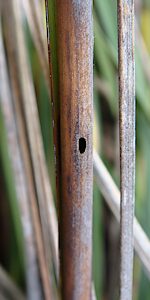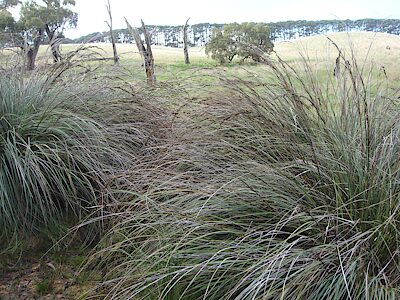Rather soft bodied, dark grey-black in colour, pronotum strongly rounded laterally, and very elongate abdomen and elytra, with hairs relatively inconspicuous.
This is highly specialised Buprestid is adapted to the larger species of Gahnia which are sedges generally known as Cutting-grasses. It is extremely common and well distributed in regard to its host plant, as I have seldom found stands of Gahnia sieberiana in the Mount Lofty Ranges that do not have the tell-tale oval exit holes made by this species on their old flowering stems.
| Legend | records | count of breeding adults, pupae and larvae |
| sites | count of major sites (unique 10 km grid cells +/- some distinct approximate localities) |
| adult | live = extracted alive; dead = extracted dead as intact or fragmentary remains; ex billet = reared and emerged from stored sections of host; ex pupa = reared from sampled pupa |
| pupa | extracted pupa; pupa ex larva = reared pupa from larva |
| larva | extracted larva (any stage including prepupa) |
| gall (only) | hatched or unhatched gall identified by form and position rather than contents |
| Plant names in green are hyperlinked to a matching host species page with plant photos. |
Adult are only known from areas where Cutting-grass or the taller Saw-sedge species occur. Larvae feed in the centre of live flowering and fruiting stems (culms) where they leave a characteristic trail of yellow frass. Exit holes are easily found on the persistent dead culms.
The main host plant in the Mount Lofty Ranges and Kangaroo Island is Red-fruit Cutting-grass (Gahnia sieberiana). However, adults were collected from Coast Saw-sedge (Gahnia trifida) on Kangaroo Island in 2006 by D.A. Young, and direct evidence of breeding in G. trifida in SA was discovered by A.M.P. Stolarski in 2023 in Deep Creek Conservation Park. It is likely that the similar Tall Saw-sedge (G. clarkei) is a larval host in the lower south-eastern part of the State.
| ¹ Legend | regions | SA State Herbarium regions (map)
EA: Eastern, EP: Eyre Peninsula, FR: Flinders Ranges, GT: Gairdner-Torrens, KI: Kangaroo Island, LE: Lake Eyre, MU: Murray, NL: Northern Lofty, NU: Nullarbor, NW: North-Western, SE: South-Eastern, SL: Southern Lofty, YP: Yorke Peninsula |
| size | The ellipse is the correct size when printed, indicative on a desktop screen, and likely to be wrong on a mobile device. |
 as unemerged adult, SL, A1_x468.jpg)
, SL, A2_x468.jpg)
 as unemerged adult, SL, A3_x300.jpg)
 as unemerged adult, SL, A1_x468.jpg)
, SL, A2_x468.jpg)
 as unemerged adult, SL, A3_x300.jpg)
 culm, SL, L1_x300.jpg)
 culm, SL, L2_x300.jpg)
 culm, SL, L3_x300.jpg)
 with exit hole in culm, SL, B1_x300.jpg)

